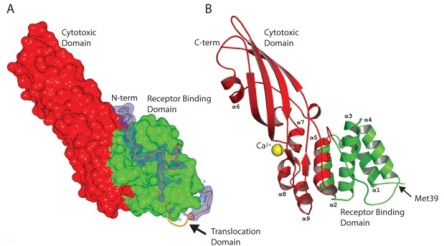Harnessing bacteriocins active against bacterial plant pathogens
Researcher:
Rhys Grinter r.grinter.1@research.gla.ac.uk
This research focuses on the identification of bacteriocins (antimicrobial proteins) produced by and active against the phytopathogenic bacteria: Pseudomonas syringae and Pectobacterium atrosepticum and carotovorum. The goal of this project is to use transgenic technology to introduce genes coding for these bacteriocins into economically important crop species susceptible to infection by P. syrinagae and Pectobacterium sp. creating transgenic plants which are capable of resisting bacterial infection.
In this project thus far we have successfully indentified a number of novel bacteriocins active against the above species and utilized a variety of structural and biochemical techniques in the characterization of these proteins (see structure of syringacin M below). Additionally these proteins have been transiently expressed using agrobacterium mediated transformation in the model plant Nicotiana benthamiana and shown to be active and highly expressed in this system.

Structure of syringacin M from Pseudomonas syringae. A, Full length structure of syringacin M showing AA 38-276 as a surface model and the unstructured N-terminus (AA 2-37) as a ribbon model (orange). The positive electron density from the Fo-Fc omit map calculated after omitting the N-terminus residues is shown as a chicken wire model at the 3 σ level. B, cartoon representation of high resolution structure of syringacin M (AA 39-276) showing receptor binding domain (green), cytotoxic domain (red) and Ca2+ ion (yellow).
Future work will focus on the characterization of these novel bacteriocins, which will provide an understanding of their mechanisms of cell entry and killing, allowing optimization of their efficacy through protein engineering. Stable transgenic lines of the model plant Arabidopsis expressing bacteriocins are under construction, which will provide an in vivo model for testing the efficacy of these proteins in preventing bacterial infection.
References
Grinter R, Milner J, Walker D. (2013) Beware of proteins bearing gifts: protein antibiotics that use iron as a Trojan horse. FEMS Microbiol. Lett. 338: 1-9.
Grinter R, Roszak AW, Cogdell RJ, Milner JJ, Walker D. (2012) The crystal structure of the lipid II-degrading bacteriocin syringacin M suggests unexpected evolutionary relationships between colicin M-like bacteriocins. J. Biol. Chem. 287: 38876-88.
Grinter R, Milner J, Walker D. (2012) Bacteriocins active against plant pathogenic bacteria. Biochem. Soc. Trans. 40: 1498-502.
Grinter R, Milner J, Walker D. (2012) Ferredoxin containing bacteriocins suggest a novel mechanism of iron uptake in Pectobacterium spp. PLoS One 7: e33033.

